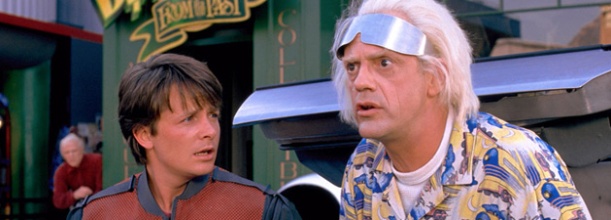Back to the Future – popping the time bubble

Everybody loves Back to the Future. We can recite the film’s plot in our sleep. However, because it’s so dazzling, charming, and funny, we’ve ended up uncritically accepting that school kid Marty McFly travels through time and, at one point, comes pretty close to becoming his own father. Suspension of disbelief is one thing, but Back to the Future avoids seeming as crazy as it should because it’s as loveable as a toilet paper endorsing puppy. But this puppy eats plutonium and breathes fire. It has a pointy time-warp tail and it firmly rejects the need for roads. And, sadly, we still need roads. It’s always a pleasure to watch, but, to really do it justice, we had better do as Doc. Brown tells us in Back to the Future III and think ‘fourth dimensionally’.
So, suppose that Back to the Future operates in a time bubble. To get involved we have to do two things. First, we need to accept the time bubble for what it is- confining our time travelling to the sofa, sure, but executed with the hip-swinging gusto of Stephen Hawking dry-humping books about space-time. Then, we have to get super-serious and try to get ourselves out of the time bubble. This will bring us safely, yes, back to the future. We have to do this as quickly and simply as we can, so we neither waste our limited plutonium supply nor do ourselves any lasting cerebral damage.
 The experience of watching Back To The Future has got much more complicated over the last 25 years. To recap: at the end of the first film, just as we think that Marty is back home in 1985 with his family woes undone, Doc Brown appears, ratcheting up the madness-per-hour dial way past the already familiar 88. Dressed like a baffled gamma-ray grandpa, he declares that he, Marty, and Marty’s girlfriend must go “back to the future”. This is when, as Marty would put it, things get “heavy.” Both the characters and the audience rightly understand 2015, documented in Back to the Future II, to be the future. This is still the case, but barely. A contemporary audience is chronologically closer to the ‘future’ of 2015 than the film’s ‘present’ of 1985 – soon, the hoverboard-heavy ‘future’ of 2015 will be an audience’s past.
The experience of watching Back To The Future has got much more complicated over the last 25 years. To recap: at the end of the first film, just as we think that Marty is back home in 1985 with his family woes undone, Doc Brown appears, ratcheting up the madness-per-hour dial way past the already familiar 88. Dressed like a baffled gamma-ray grandpa, he declares that he, Marty, and Marty’s girlfriend must go “back to the future”. This is when, as Marty would put it, things get “heavy.” Both the characters and the audience rightly understand 2015, documented in Back to the Future II, to be the future. This is still the case, but barely. A contemporary audience is chronologically closer to the ‘future’ of 2015 than the film’s ‘present’ of 1985 – soon, the hoverboard-heavy ‘future’ of 2015 will be an audience’s past.
This ends up meaning that an audience watching Back to the Future in 2020 will see Marty McFly travel back to what they understand to be the past. Perhaps this will make it fantasy history made by the 1980s imagination rather than genuinely futuristic sci-fi. For the hypercynical, this is obvious and boring. However, the sensitive might ask whether this means that the sci-fi element of the film will eventually, naturally, peter out? No, it doesn’t. This would be to forget that storytelling conventions age just like the stories themselves. Somehow, in making a senility-baiting epic, Spielberg presents something timeless: the single most mind-bending concept available to us dished up as mass-entertainment. The film series spans more than a century, showing Marty travelling to infinity and a little bit further in a surge of fluorescent sparks and fake fire. However, all these events take place during just one day in his life- the day in which he left for school at 8.25AM. Our time bubble is framed at each end by 1885 and 2015, entered at different points after 1985 by different audiences, and takes place across only 24 hours.
A cultural paradox? Great Scott!
Now, unfortunately, to get ourselves out of this time bubble, we have to get clever. The time bubble raises two hefty questions. First, is the experience of watching Back to the Future affected by the time in which we watch it? Second, would an original audience, watching it 25 years ago, have a different experience? The answer to both is “yes.” Obviously, we always come to a film with our own concepts and ways of understanding things that are conditioned by the time we live in, and a 21st century audience will watch Back to the Future with its own ideas affected its own experiences. This affects how we understand the technology Doc. Brown uses- laughably slow, hopelessly outdated. It affects the way we hear the music Marty listens to and the clothes he wears- rambunctious, naff, and totally lacking in irony. Most importantly, it affects the way we see through the film’s production values. With a budget of $19million, Zemeckis has been able to embellish the look of 1985 while also creating a photogenic, hyper stylised, 1955 dripping with dewy-eyed nostalgia. These production values look old-fashioned to a 21st century audience, meaning that we’re watching an old-fashioned depiction of things that are already old-fashioned: 1955 ends up looking doubly dated. Further, the viewer adds an extra layer of knowing nostalgia to the film’s ‘present’ of 1985 that make it seem as quaint as charming as the film seems to consider 1955. Heavy, huh?

Back to the Future is a part of our cultural DNA, and our eyes have flickered across it enough times to make most commentary about it seem rehashed. Hopefully, by scaring ourselves out of our space-time skins, we’ve rehabilitated the film’s sci-fi bits in our own 21st century terms. We’ve learned that time conditions the eyes we use to see films and the things that we can say about them. Fortunately, Back to the Future is being brought back to the silver screen on October 2nd, so we all have the chance to see it again and blow some time bubbles. The unrelenting pursuit of technological advance might mean that the eyes we use to see films have to adjust themselves more quickly to new conditions. However, Back to the Future manages to survive the march of obsolescence with a wink and a nod and a searing guitar solo, gleefully threatening our existence and jeopardising the balance of the space-time continuum. It might be too much to suggest that Back to the Future is a time machine itself but, without cranking up to 88 miles an hour yourself in the cinema, you’re never going to find out.





Recent Comments